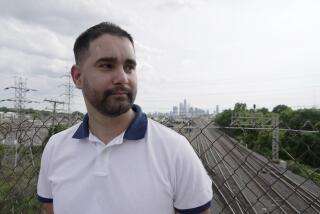New Hope, New Challenges for HIV-Positive
- Share via
A little over a year ago, Fred Foy learned that the disease he had thought was going to kill him was in remission, thanks to new drugs.
Instead of contemplating how he would die of AIDS, he suddenly asked himself how he was going to live-- and how he would go back to work after five years of inactivity and dread.
For years, AIDS had sapped Foy’s strength, forcing him out of a career as an agent representing fashion models and actors. Could he come back to the film business? Renew his contacts? Would he be forced into a different line of work?
There are an estimated 50,000 HIV-positive men and women living in Los Angeles County, according to Steed McCotter, senior assistant for education at AIDS Project Los Angeles. A quarter of them have developed AIDS, but thousands like Foy, after years of awaiting death, have recently been told that they may live nearly full lives, thanks largely to new protease inhibitor drug cocktails.
Institutions are just now coming to grips with the consequences. Last month, the federal Centers for Disease Control and Prevention held its first forum to explore the challenges associated with AIDS in the workplace, inviting 350 executives, human resources professionals and public health specialists. A 1996 survey by the center found that one in every six large companies has a worker with HIV or AIDS.
Foy’s odyssey is an example of the struggles they face.
One day 13 years ago, Foy, then 25, skipped his usual business lunch at Le Dome in favor of a visit to a West Hollywood HIV-testing clinic.
It was the second time Foy had gotten anonymously tested. The first time, he had been too afraid to return for the results. This time, he convinced himself, he would confront his fears and get on with his life.
He was wrong. Not only had he tested HIV-positive, he had, a nurse told him, only a year to live.
Like many other HIV-positive individuals, Foy stayed at his job a couple more years. Then he quit and founded his own agency, Specialty Models and Talent, which did business for five years, including opening a satellite office in New York.
“I thought, ‘You have your health; go for the big bucks now, to take care of yourself when you get sick,’ ” he recalls.
Five years ago, the HIV turned into AIDS. He closed his agency, cashed in his life insurance, gave up his condo--and redirected all his energies to staying alive. By 1995, he had dropped 40 pounds. “I was getting very close to the criteria I had set for when I would euthanize myself,” he says.
Months earlier, he had helped his best friend, a former bodybuilder, plan his own funeral. After saying goodbye for the last time, Foy left his friend’s apartment, walked over to Venice Beach, stood by the ocean and “bawled my eyes out.”
On Foy’s shelf, right by the book “Surviving AIDS,” was “Final Exit,” a how-to manual on suicide.
Last year, however, the new protease inhibitors renewed Foy’s health. To his surprise, he began thinking about reentering the job market.
It was clear to him he could not go back as an agent. He knew the long hours and endemic back-stabbing could now literally kill him. But he’d long had a related career dream, even when he thought he was dying, of creating special effects for films.
As he pondered this, a friend told him about a computer learning center run by Project New Hope for people with AIDS or HIV. The center, in the back of a Hollywood church, retrains up to 40 people at a time, with the average student enrolled six to 12 months, says center Director Ivan Rukavina.
“Many who come here have been isolated,” said Rukavina. “Classes are a way to bridge the gap, to get them out of the house to become part of something.”
So, mixed in among conversations about word processing programs are discussions of the relative merits of the newest protease inhibitors, as well as how to return to work without jeopardizing their health with job-related stress.
In some ways, the learning center provides a dry run for the workaday world.
Foy struggled through a relapse, hospitalized for kidney stones, a side effect of his drug regimen.
“Fred was pretty obsessed about achieving his goals,” says service coordinator John Riley. “A day after he had been released from the hospital he was back in class.”
Most students at the training center, having stared death in the face, undertake vast career shifts. Not Foy. But the specialized knowledge he needed to move into special effects required technological training beyond New Hope. So with the help of New Hope training counselor Terry Hart, Foy applied to a USC program for those downsized from a job. This fall, he became the only identified HIV-positive student in a 14-person class.
On his first day, Foy was nervous, uncertain about how he would be greeted. When some of his classmates found out about his HIV-positive status, they shied away from him, he said.
Others, such as 31-year-old Tam Tran, found Foy’s presence “very hopeful” and asked Foy’s advice for an HIV-positive friend. Fellow student Bill Kenny, 44, found himself impressed by Foy’s intricate graphic designs. “The class is a team, and Fred is helping lead the team,” he said.
Instructor Mary Vasassilakis, who had watched a friend die of AIDS, also encouraged Foy.
Meanwhile, Foy made changes in his life. To focus on his recovery, he put limits on his private time, getting an unlisted number to avoid calls from former clients, and strengthening his bonds with his parents and other family members.
Returning to the workplace remains daunting, however. “My disease is on hold, but not cured. My issue is to avoid getting sick.”
His biggest hurdle, however, may come when he applies for a job.
“I have to be savvy about seeking out opportunities. I can’t wait for them to present themselves,” he said. “A couple of years ago, my goal was just to hang on for another year. That was the best goal that I could realistically set for myself. Now, for the first time, I have hope.”
More to Read
Sign up for Essential California
The most important California stories and recommendations in your inbox every morning.
You may occasionally receive promotional content from the Los Angeles Times.










